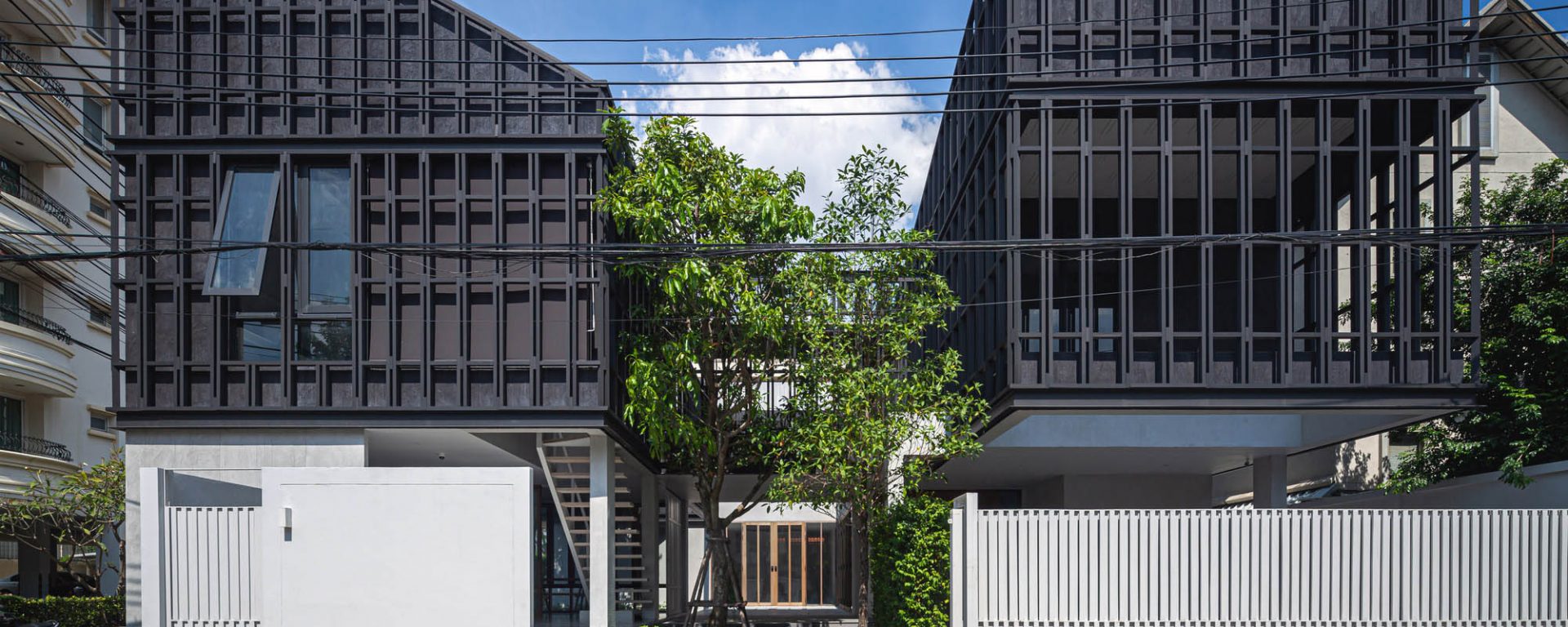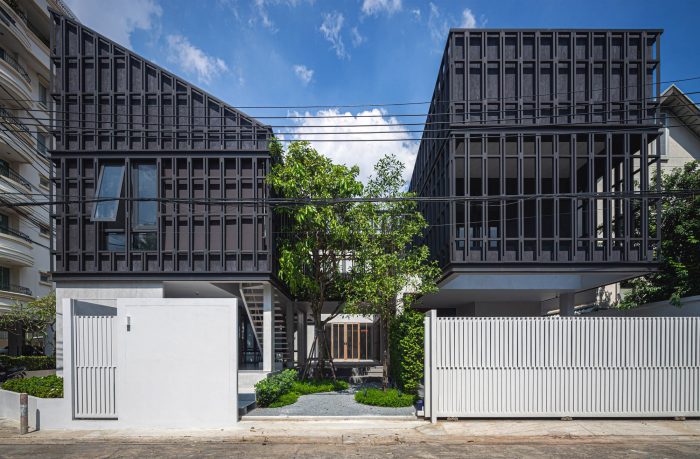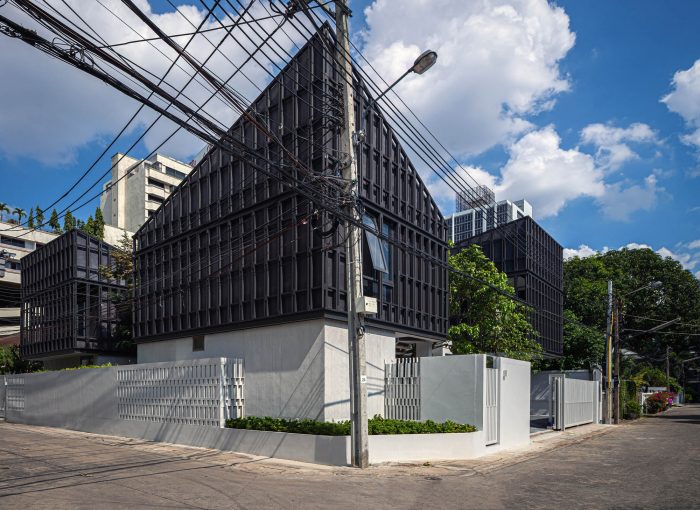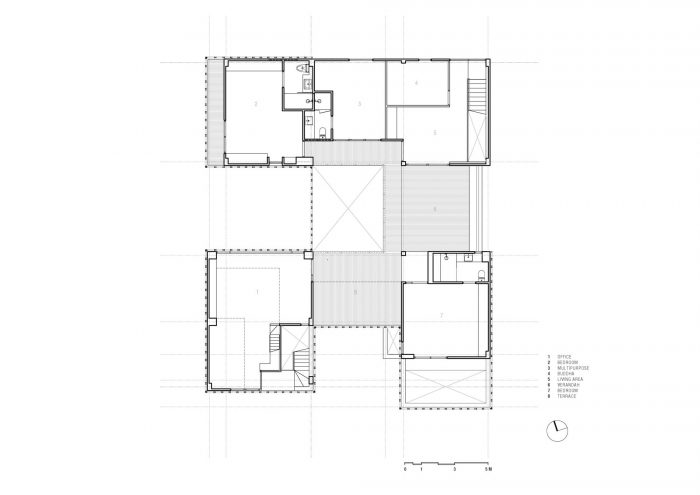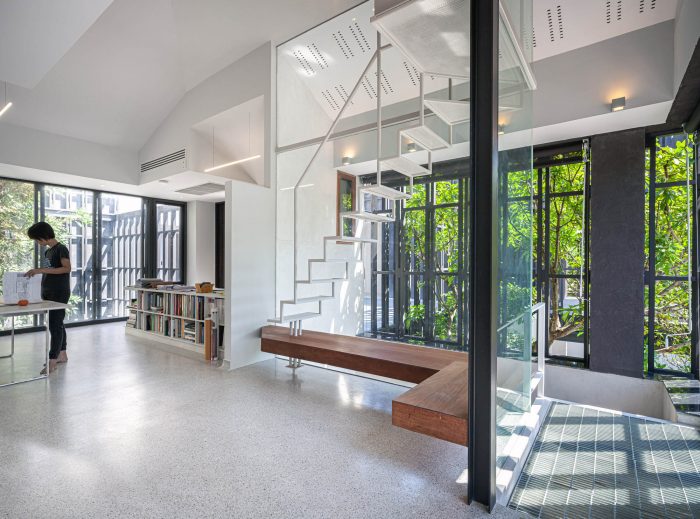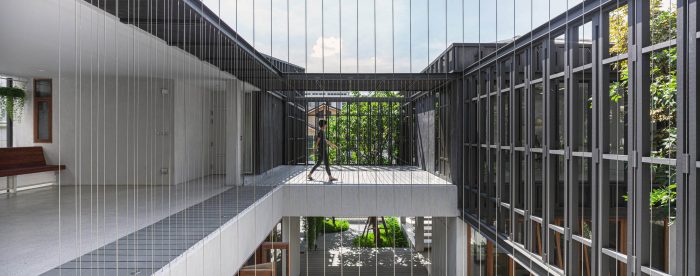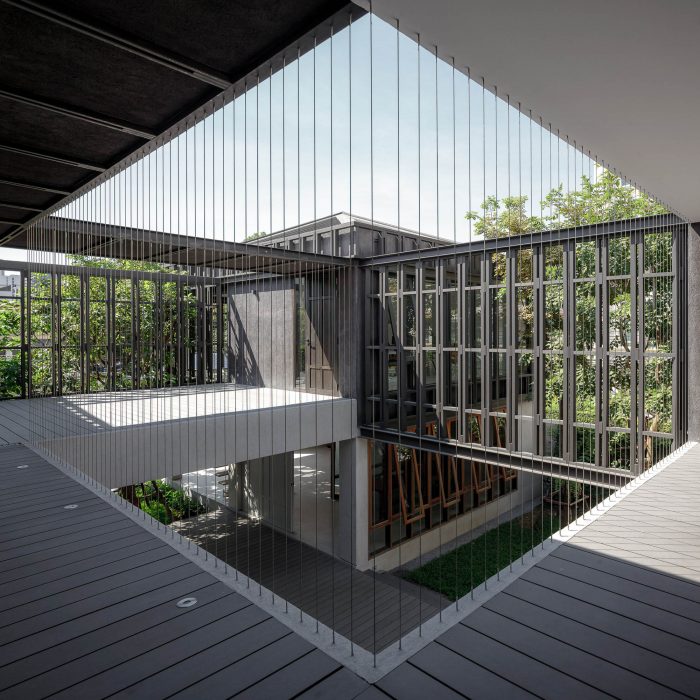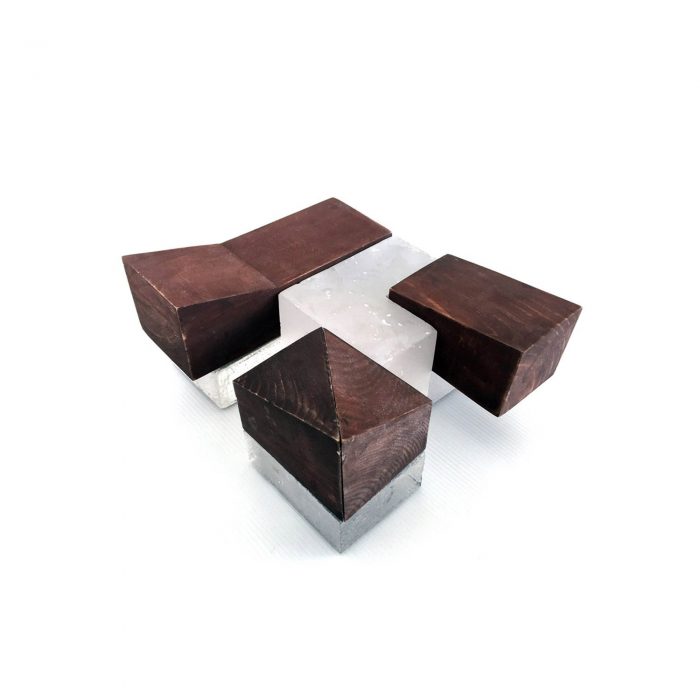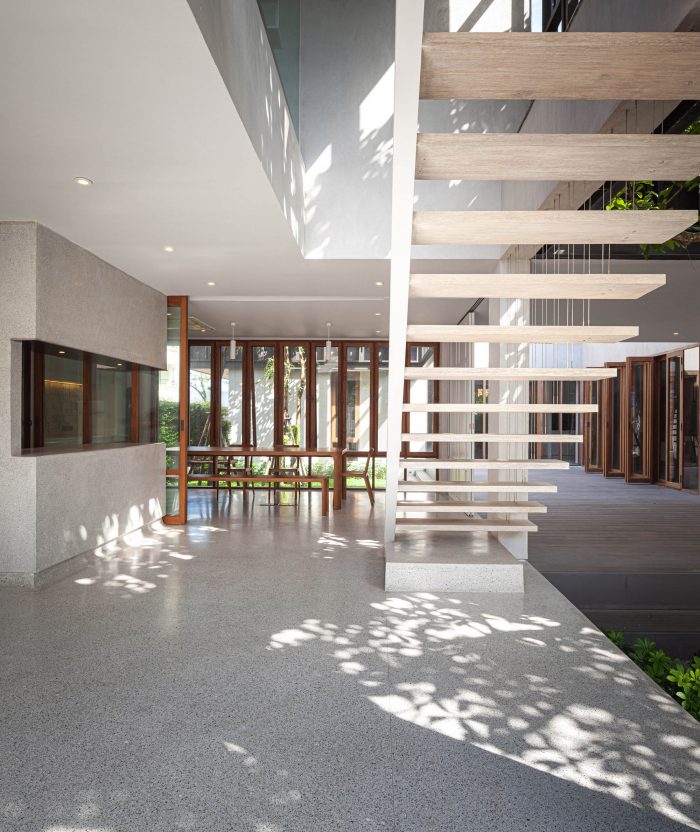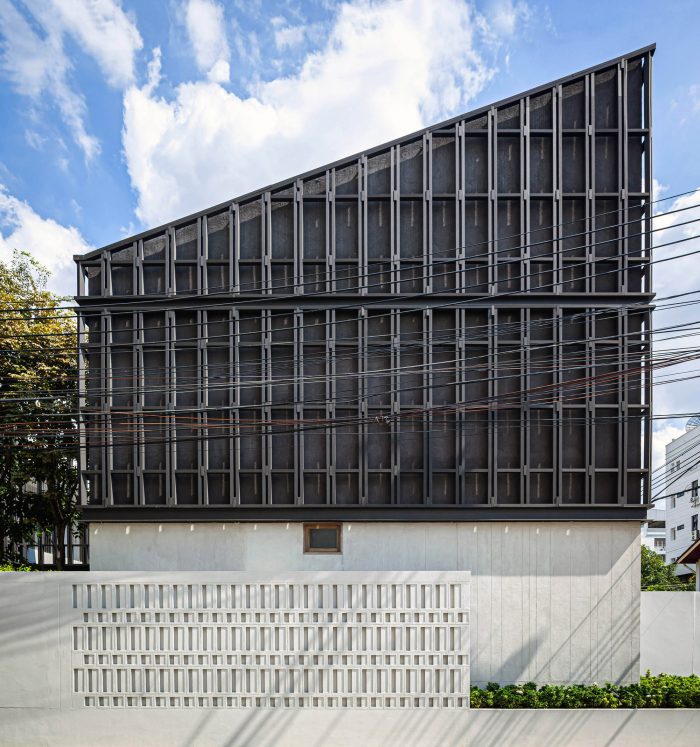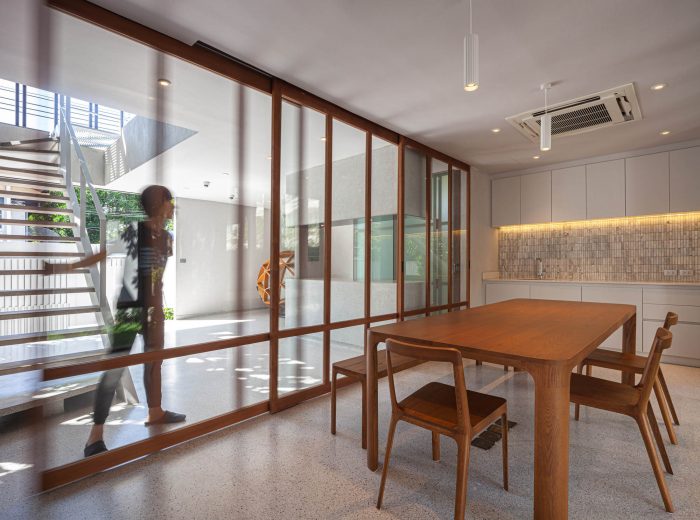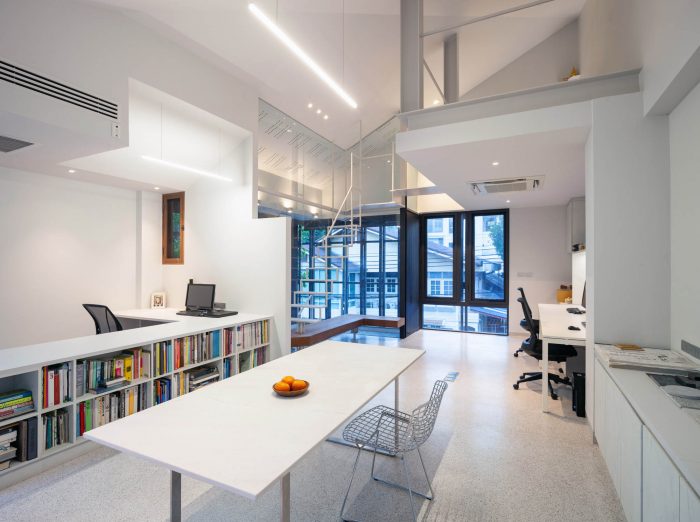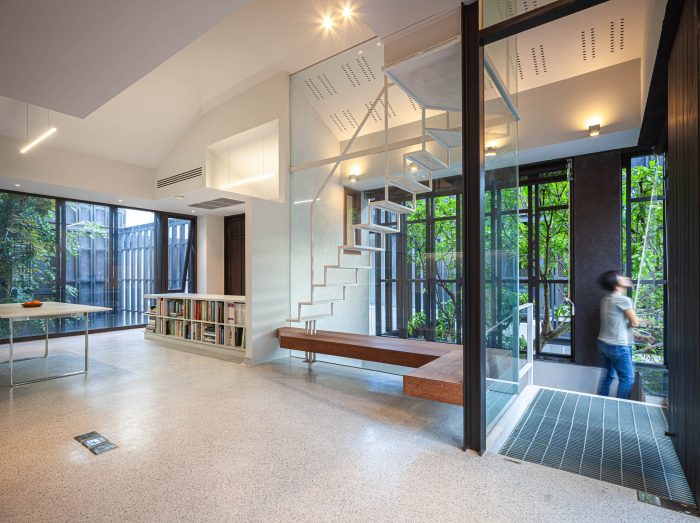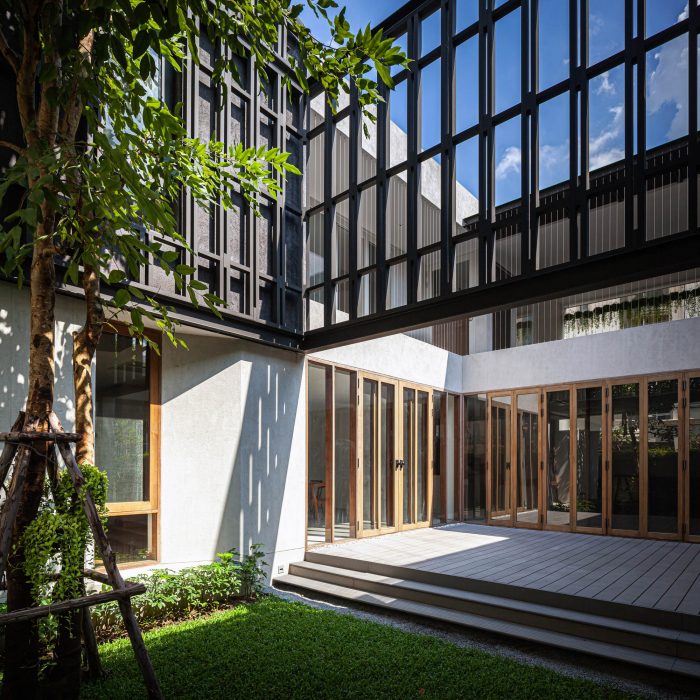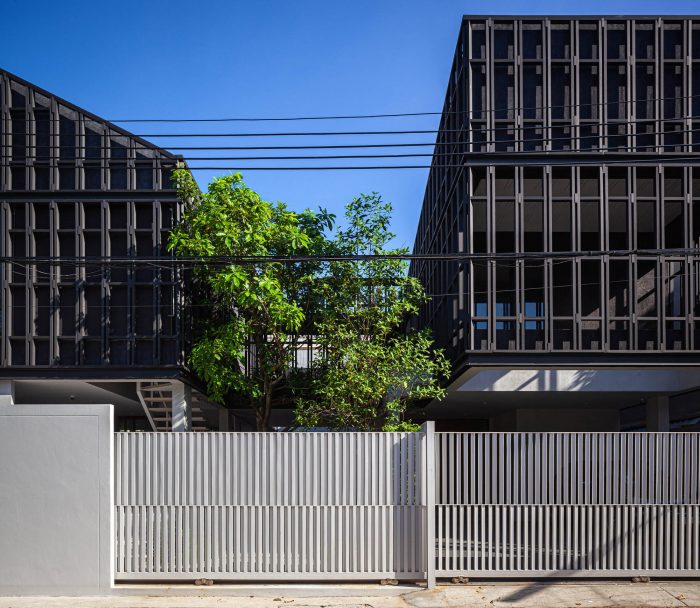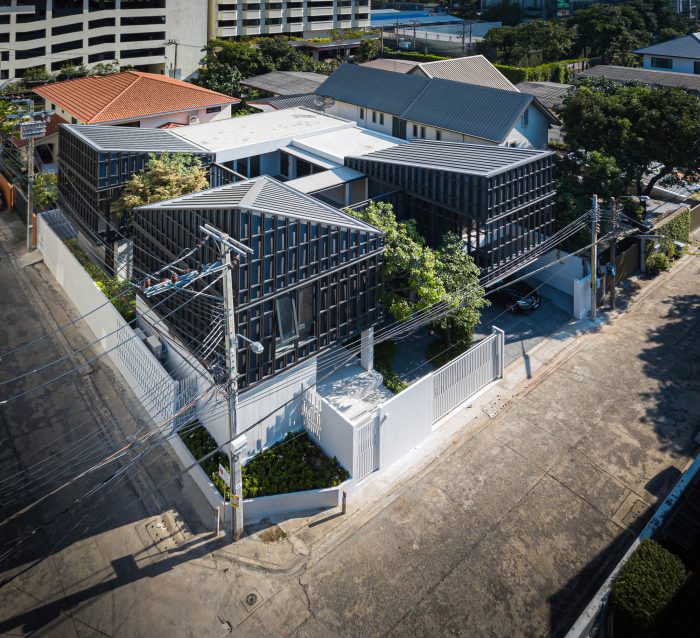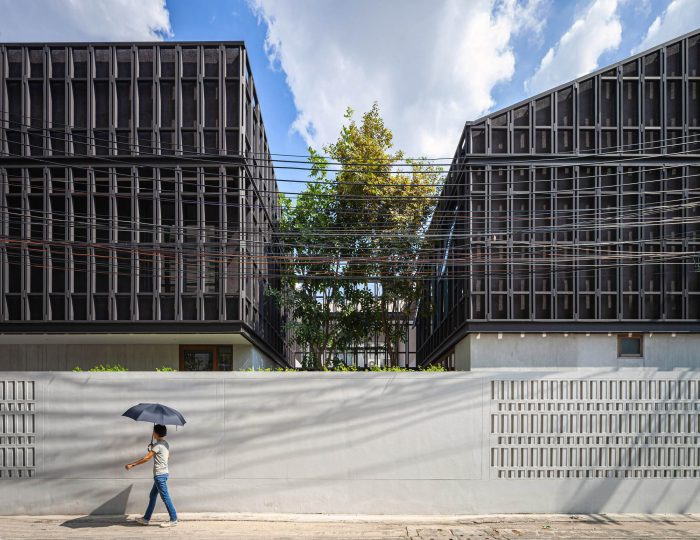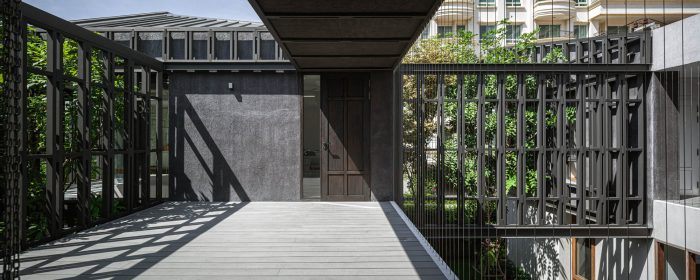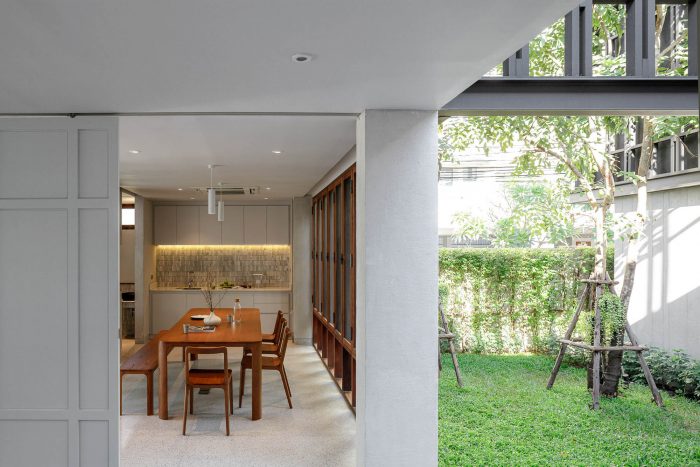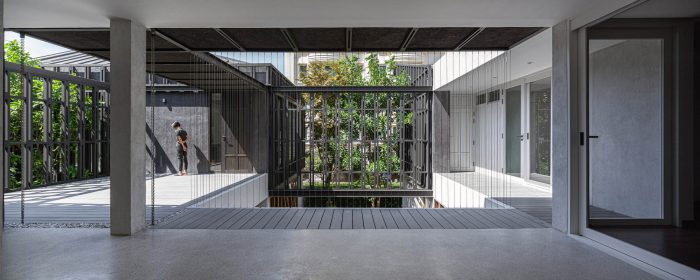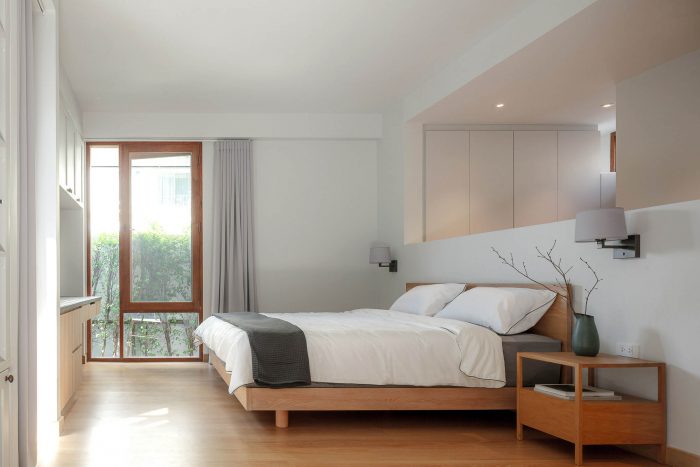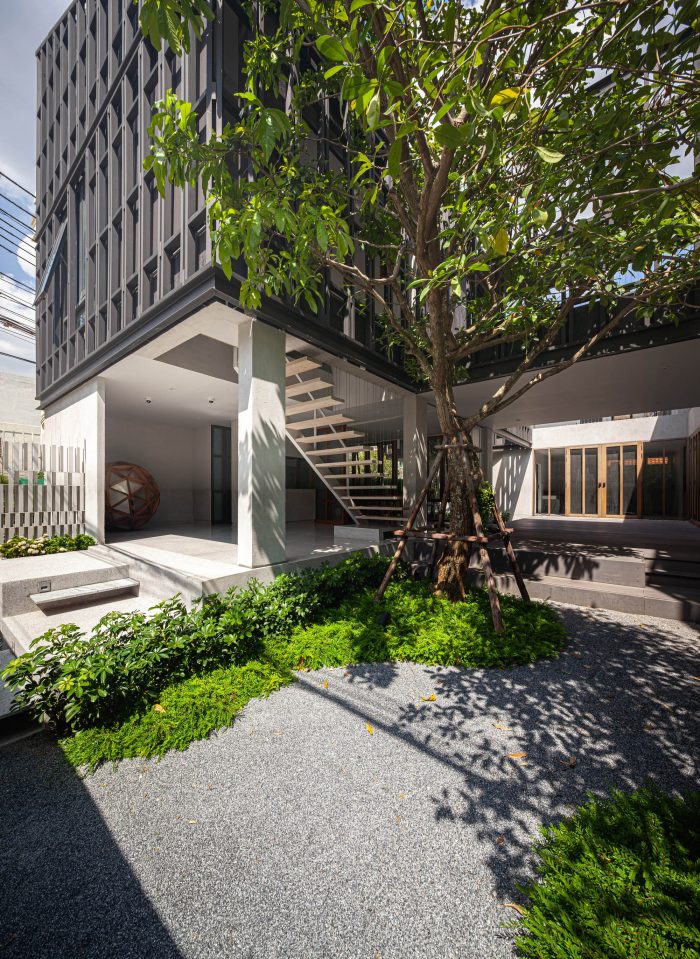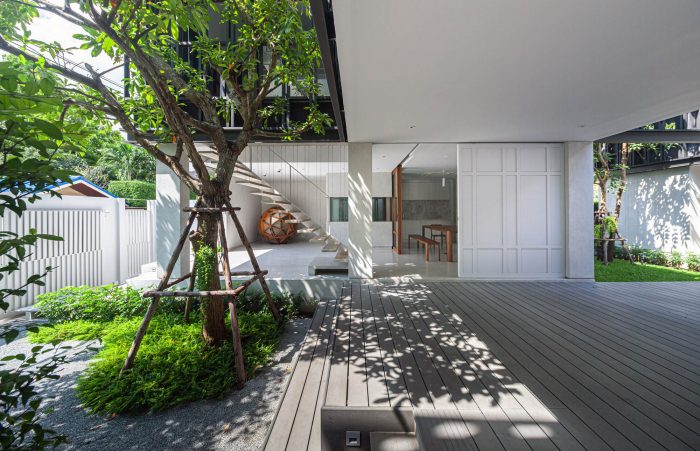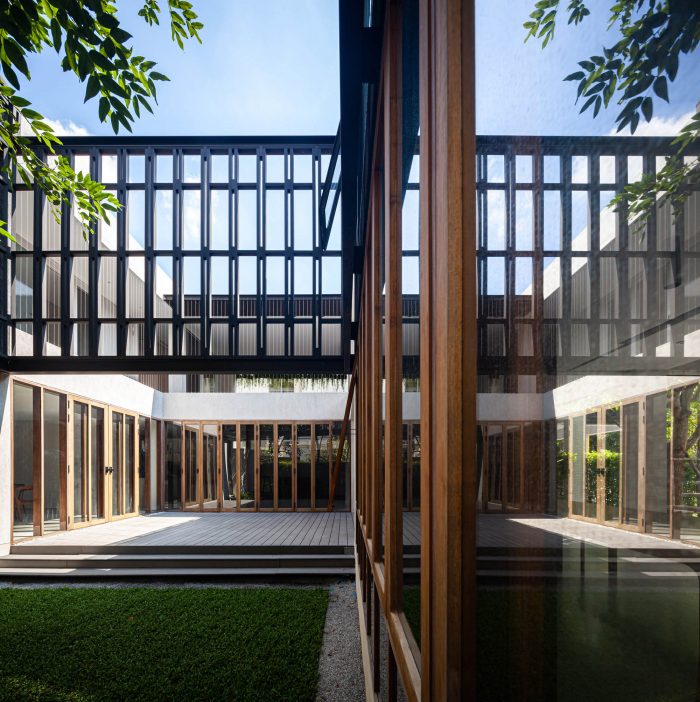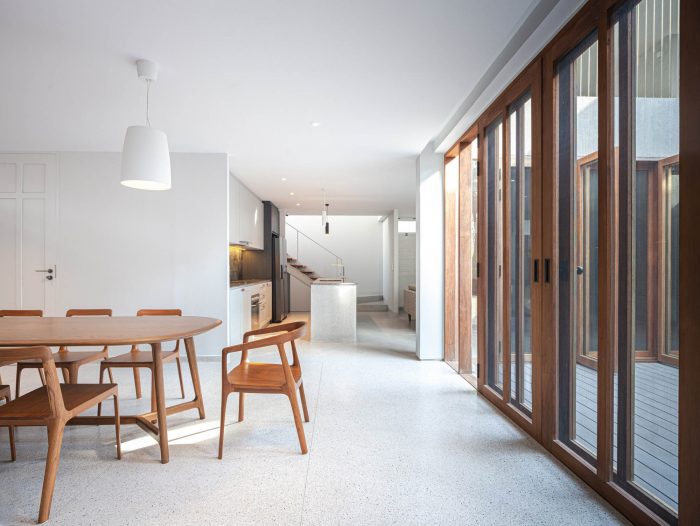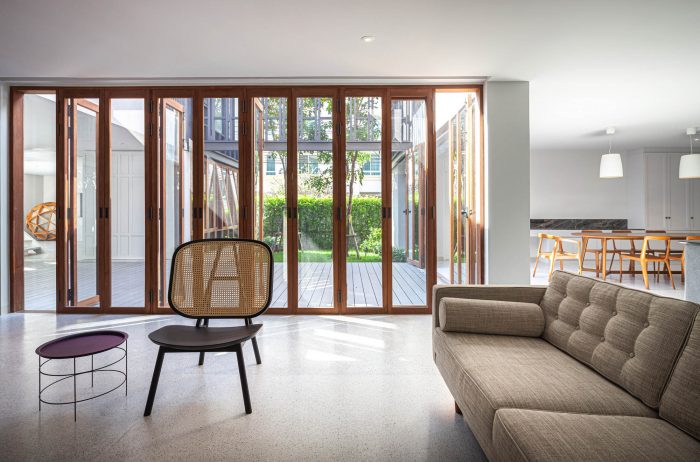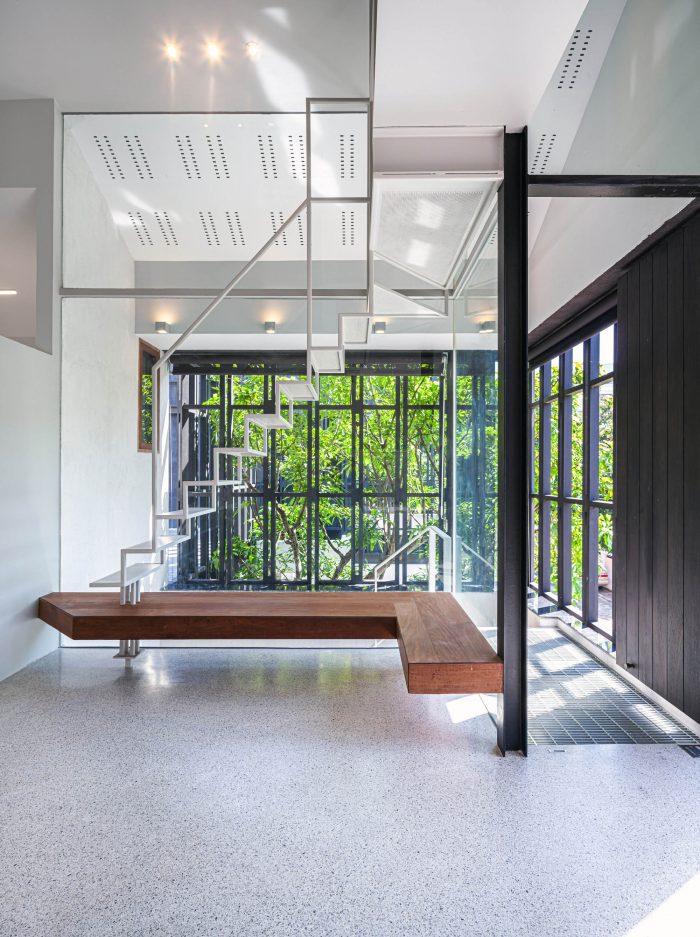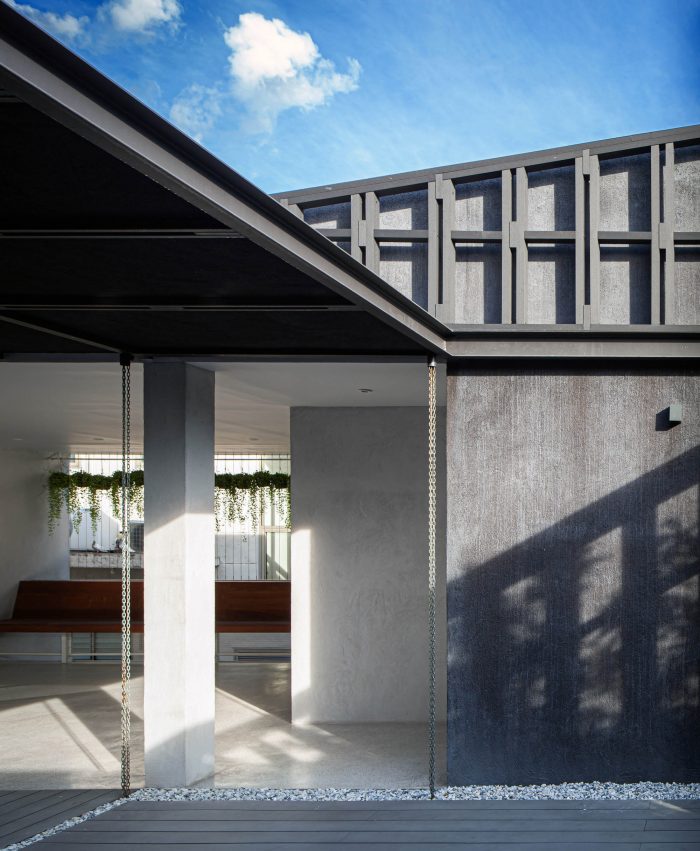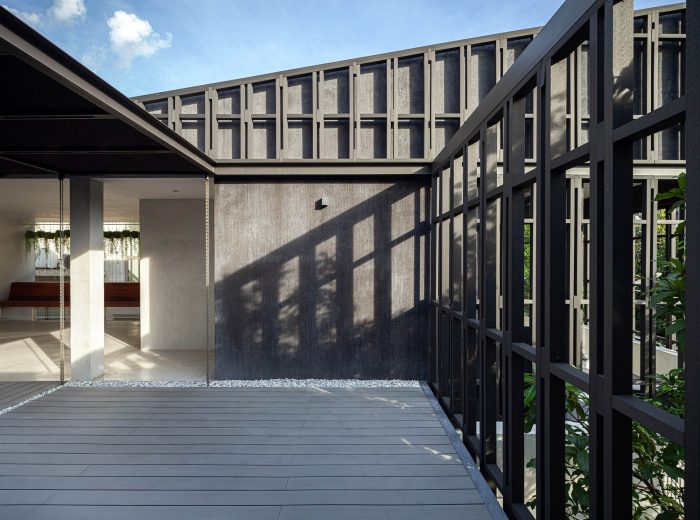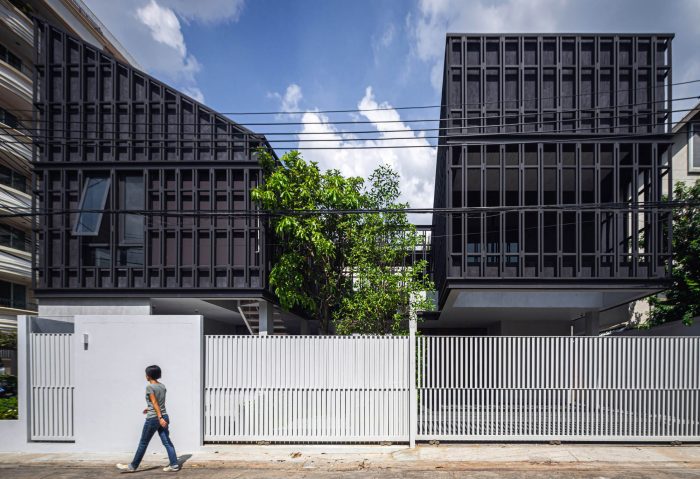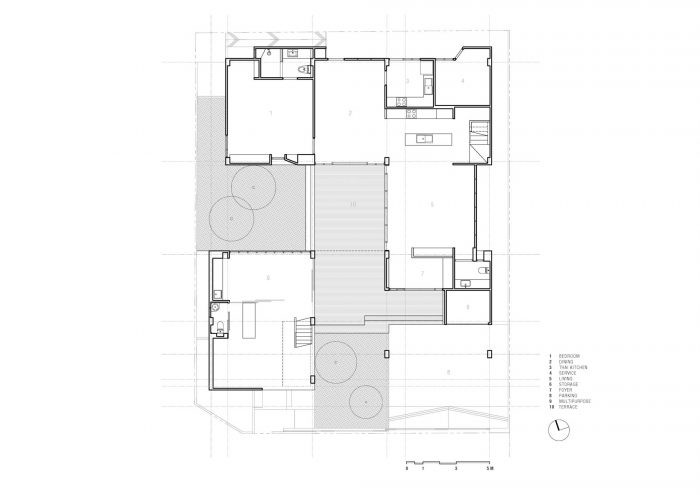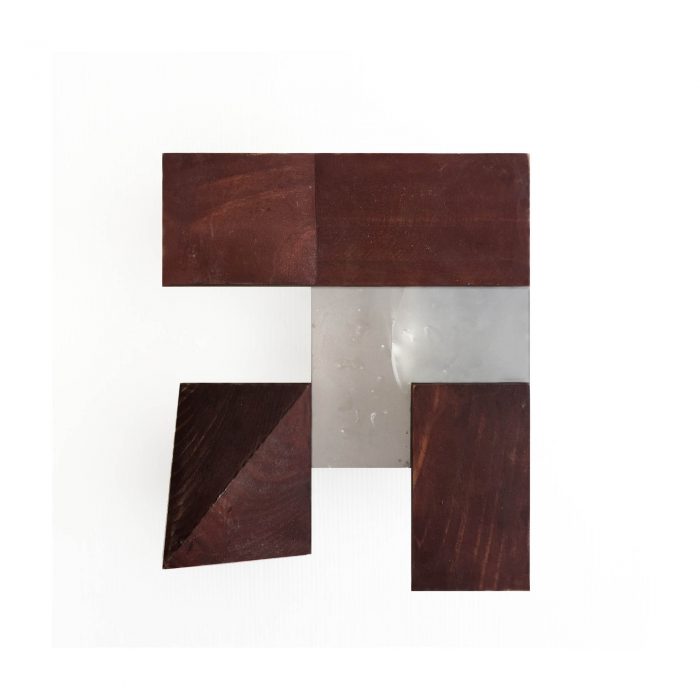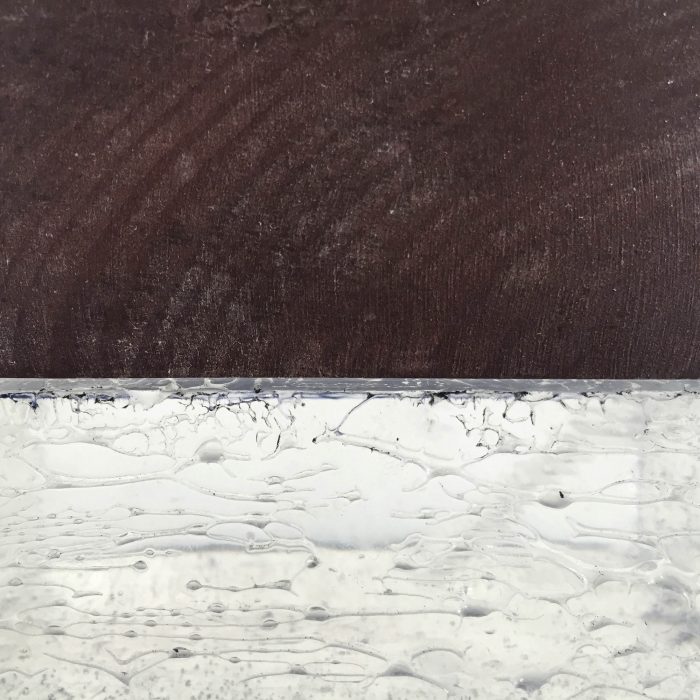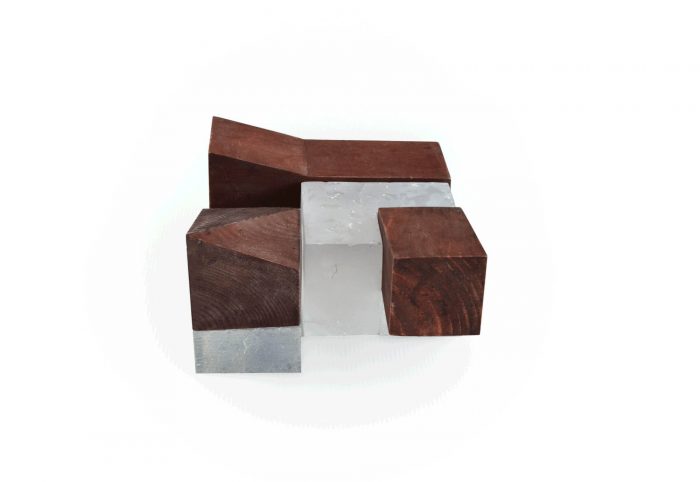第一栋11号院是11号院二号院的建筑师–业主的童年家园。这座简陋的两间卧室、两层楼高的独立屋,有一个两车位的车库,住着一家五口,后来因为需要更多的空间而搬走。后来结构被拆除,财产被清空,历时近二十年。最近,其中一个兄弟姐妹回到社区,在老家的土地上重新建造。建筑师将11号II号–一座新的三室两层楼房叠加在第一座房子近似L型的基座上。在芒果树生长的老草坪上,在地段的西南角,现在坐着一个附加物–一个双层建筑,里面是建筑师的办公室。
The first House #11 was the childhood home of the architect-owner of #11 II. The modest two-bedroom, two-storied detached house with a two-car garage housed the family of five, which later moved out due to the need for more space. The structure was then demolished, and the property emptied, for nearly two decades. One of the siblings has recently returned to the neighborhood to re-build on the old family lot. The architect superimposed #11 II –a new three-bedroom, two-storied house—on top of the approximate L-shaped footprint of the first. Over the old lawn where mango trees grew, at the southwest corner of the lot, now sits an addition –a double-storied building that houses the architect’s office.
将住宅和办公室与两层的室外露台连接起来,实际上,形成了一个由四条线(#)划定的九个区组成的建筑院落–向经典的九方格教学工具致敬。在480平方米的小地块上,额外的方案需要尽量减少四面的周界后移,这就造成了内部花园和开放空间的空间配置。
Connecting the residence and the office with outdoor terraces on both levels, in effect, makes an architectural compound of nine quarters demarcated by four lines (#) —a nod to the classic nine-square-grid pedagogical instrument. On the small plot of 480 sqm, the additional programs necessitate minimizing perimeter setback on all sides, which results in the spatial configuration that internalizes gardens and open spaces.
两个绿色的庭院占据了九个宿舍中的两个,而中间则完全向天空开放。上层的卧室和办公亭子都是高高的天花板,排列在独立的角落里,被黑色格子外墙所包围。开放式的露台、阳台和走道连接着各个亭子。其空间特征类似于传统的泰式住宅(Ruen Thai),其中单个的亭子–卧室(Ruen Non)、起居室+餐厅(Hor Nang)、厨房(Ruen Krua)–围绕着一个高架平台上的开放平台(Charn)。
Two green courtyards occupy two of the nine quarters, while the center is left entirely open to the sky. Bedroom and office pavilions on the upper level are high-ceilinged, arranged in separate corners, and enveloped in black latticed facades. Open terrace, verandah and walkway connect the pavilions. The spatial characteristics resemble that of the traditional Thai house (Ruen Thai), in which individual pavilions –bedrooms (Ruen Non), living + dining area (Hor Nang), kitchen (Ruen Krua) — are clustered around an open terrace (Charn) on an elevated platform.
办公室的底层是多功能和通风的,有充足的开口和滑动隔断,模仿了本色Ruen Thai的平台(Tai Thun)下的多功能底层空间。黑色的格子外墙是由木塑复合材料制成的预制板。
The ground floor of the office building is multipurpose and airy, with ample openings and sliding partitions, mimicking the versatile ground floor space underneath the platform (Tai Thun) of the vernacular Ruen Thai. The black latticed facades are prefabricated panels made of wood plastic composite.
虽然它们的(预制)方法参考了构成Ruen Thai墙面的花纹木板(Fa Pakon),但其图案是抽象的,颜色是饱和的和强化的,美学是当代的。黑色的表皮包裹着实墙和空隙,统一了整个上层,形成了一个看似单体的高架群,盘旋在底层单色的白色组件之上。
While their (pre)fabrication method references that of patterned wood panels (Fa Pakon) that constitute Ruen Thai’s walls, the pattern is abstracted, the color desaturated & intensified, and the aesthetics contemporized. Wrapped over both the solid walls and the voids, the black skin unifies the entire upper level, forming an elevated cluster of seemingly monolithic masses that hovers over the monochromatic white components of the ground floor.
怀旧在其余的材料调色板中扮演着重要的角色。新的材料–最突出的是外墙和外部平台的木塑复合材料–被刻意地与第一栋房子11号的旧材料相抗衡:水磨石、泰国当地的大理石、木制门窗、有质感的水泥涂料、风化的黄铜硬件和配件。旧的记忆被保存在新的材料中。
Nostalgia plays a significant role in the rest of the material palette. New materials —most prominently the facades’ and exterior decks’ wood plastic composite—are deliberately countered with the old set of materials from the first House #11: terrazzo, local Thai marble, wooden doors and windows, textured cement render, weathered brass hardware and fittings. Memories of the old are preserved within the materiality of the new.
建筑师:Beautbureau
面积:550 m²
年份:2020年
摄影作品:Spaceshift Studio, Soopakorn Srisakul
厂家:Bluescope, Hafele, Lamptitude, Goodseal, Haro Laminate Floor Tritty 100, Hybrid Wood, Ligman, Modernspec, Muangthong, SCG Tiger Décor Texture Render, Stone Stylist Granblex, Strudyna, TGSG Thai-German Specialty Glass
首席建筑师:Bea Vithayathawornwong
结构工程师:Next Innovation Engineering
照明设计师:Atelier Ten Bangkok
承包商:Siam PYC Engineering
城市:曼谷
国家:泰国
Architects: Beautbureau
Area: 550 m²
Year: 2020
Photographs: Spaceshift Studio, Soopakorn Srisakul
Manufacturers: Bluescope, Hafele, Lamptitude, Goodseal, Haro Laminate Floor Tritty 100, Hybrid Wood, Ligman, Modernspec, Muangthong, SCG Tiger Décor Texture Render, Stone Stylist Granblex, Strudyna, TGSG Thai-German Specialty Glass
Lead Architect:Bea Vithayathawornwong
Structural Engineers:Next Innovation Engineering
Lighting Designer:Atelier Ten Bangkok
Contractor:Siam PYC Engineering
City:Bangkok
Country:Thailand

